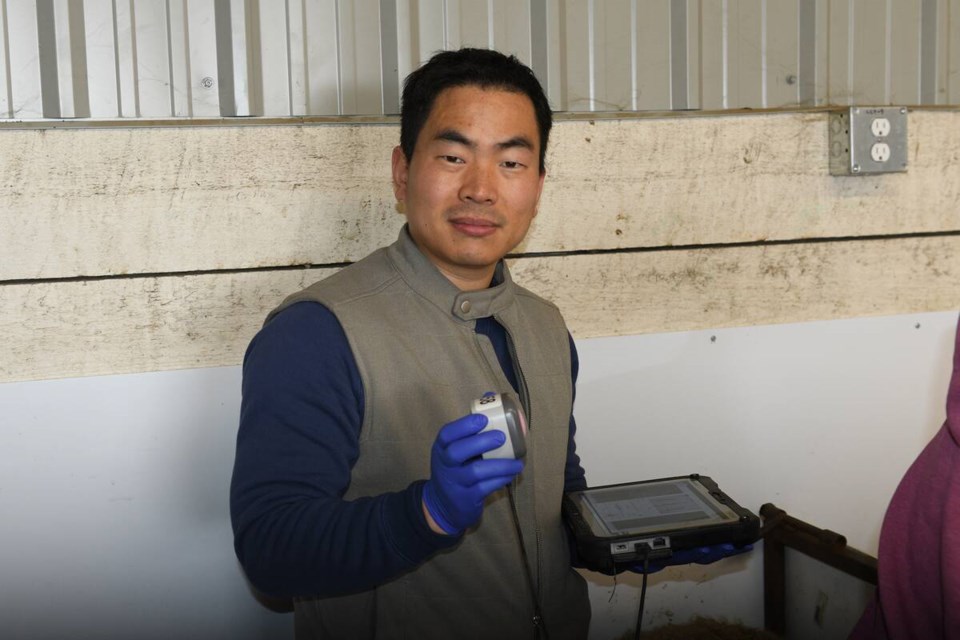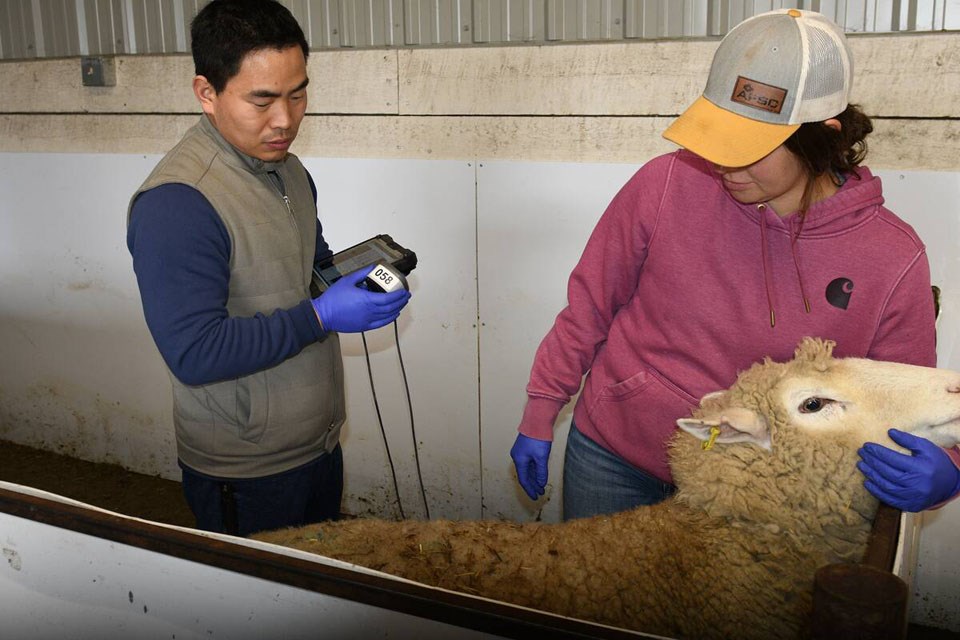WESTERN PRODUCER — Researchers at Olds College in Alberta are using vibrations and artificial intelligence to diagnose what’s going on inside a sheep, but with a simpler package than typical veterinary imaging technology.
The small device, known as the imPulse Una, is an infrasound to ultrasound AI stethoscope.
“The technology was invented by Level 42 AI in the Silicon Valley in California,” said Yaogeng Lei, research scientist at the Technology Access Centre for Livestock Production at Olds College.
In 2022, Level 42 AI opened their Canadian branch in Edmonton at the University of Alberta. They named it Vibrome Canada and decided it would hold all the company’s intellectual properties for animal research.
After Olds College connected with Vibrome Canada, the two struck a deal to collaborate on trialling the technology for sheep.
“The first time when they came over to visit us and they showed us the technology, it was very cool for us to look at,” said Lei.
From sound to ultrasound
Infrasound refers to sound waves below the frequency of human hearing, while ultrasound waves are high frequency.
It’s that higher sound frequency window that most think of when it comes to medical imaging of soft tissues, whether in a sheep or a person.
The imPulse Una, however, runs a much wider range. It tracks acoustic signals from the infrasound to the ultrasound, including both audible and inaudible vibrations. From there, the system’s artificial intelligence and machine learning algorithm makes sense of the sound patterns. All information is transferred to Vibrome via the cloud.
Data collected from the vibrational frequencies can be linked to the animal’s health, physiology and age.
“But all this work needs a lot of data collection to build the model first. What we are currently working on is the initial data collection,” he said.
 Yaogeng Lei, research scientist with the Technology Access Centre for Livestock Production, is developing technology powered by artificial intelligence that can detect parasites and check for pregnancy in sheep. | Photo courtesy Olds College
Yaogeng Lei, research scientist with the Technology Access Centre for Livestock Production, is developing technology powered by artificial intelligence that can detect parasites and check for pregnancy in sheep. | Photo courtesy Olds College
Practical applications
The college and company first set their eyes on using the technology to detect barber’s pole worm.
“It’s a very important parasite infection in sheep, in the small ruminants,” Lei said.
Mature worms live in the stomach of sheep and goats, suck on the stomach membranes and drink the animal’s blood. If there’s enough of them, the animal becomes anemic.
“In severe cases, the animal would drop dead,” said Lei.
This typically happens in the early spring, when worms from the previous year wake from hibernation and continue to mature.
They can also become an issue for young lambs who go out on pasture and pick up the parasite.
“If they ingest enough worms, they could also have a severe reaction,” the researcher noted, adding that, even in less severe infections “the animals would still suffer from production loss because they must fight with the parasites, who create wounds in their stomachs.”
One University of Calgary study also noted burgeoning treatment challenges. After testing 20 sheep farms, the study found an alarming number of barber’s pole worms already resistant to dewormer.
Lei said this indicated a need for better parasite management plan for sheep flocks. Currently, there are only two approved dewormers for sheep in Canada.
The trial, which put the imPulse Una to work looking for signs of infection, verified results with blood and bowel markers to identify parasite infections.
Sheep were separated into four groups. Two groups were a control, while the others were inoculated with barber’s pole worm larvae. Of the two inoculated groups, one group was left untreated, while the other one was treated with dewormer on day 28.
Before that treatment, though, researchers pulled out the imPulse Una.
“We collected (data) for 10 animals from each group in December,” said Lei.
The AI stethoscope gathered data from five locations on each animal: the heart, lungs, neck, stomach and intestines.
Results showed the device was able to distinguish infected ewes from non-infected ones on day 28.
Researchers followed up their data collection on day 35, 42 and 56.
The research team then looked at ewe pregnancy checks. It was Lei’s thought that, if the device could detect parasites in the stomach, it should also work for a fetus.
Those pregnancy check trials began last winter. Again, researchers collected vibrational signal data from different locations of the sheep’s body, including the neck, heart, lungs and regions where the fetus would be developing.
They then did ultrasound scans on the same animals in late January and early February to compare the accuracy of their AI machine learning model.
Researchers are currently collecting data on the end results of those pregnancies, such as lambing date and number of lambs from each ewe. They are still waiting for some animals to lamb.
Once they do, all the data collected will be shared with Vibrome to build linkages between the data and real-world results.
Farmers may one day be able to preg check their own sheep using the system. That would be a boon in an industry where there aren’t enough ultrasound techs or veterinarians to go around.
“I’m hoping the pregnancy check will be the first commercial function that the company can sell to farmers,’” Lei said.
Outside of livestock, the researcher noted, there’s implications for human health. The device could conceivably be used to detect preeclampsia and gestational diabetes in pregnant women earlier and more accurately.
About the author
Related Coverage
Olds College appoints new president and CEO
Floating islands could help filter cattle feedlot storm ponds
Olds College animal health programs to start thrice-yearly intakes this fall
Olds College suspends Fall 2025 intake for multiple programs
Automation, artificial intelligence shift focus of farm labour gap

